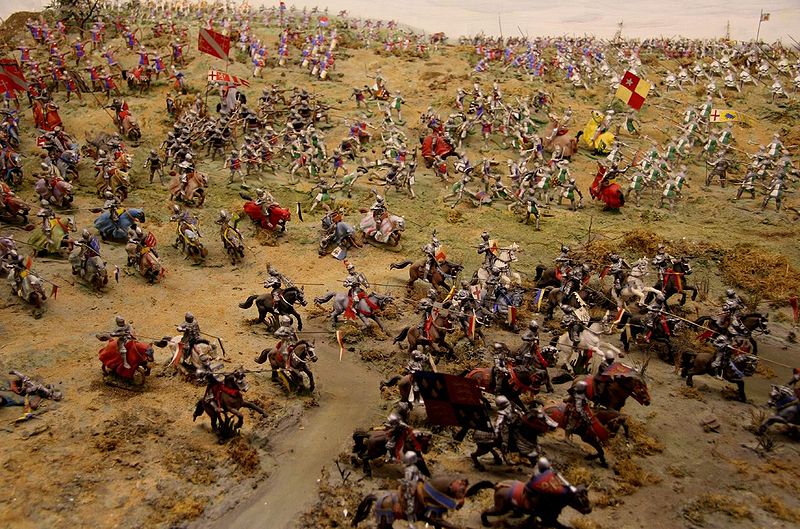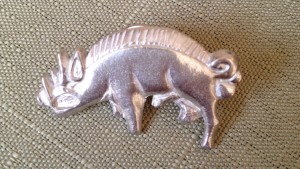I am delighted to share with you a guest article written by my friend Mike Glaeser from Blogging4History, about the Battle of Bosworth, which took place on this day 528 years ago. Happy Reading!
The Real Battle of Bosworth by Mike Glaeser
To understand the Battle of Bosworth, one needs to remove a lot of preconceptions. While it was the decisive battle in the Wars of the Roses, it was not the last. That distinction belongs to Stoke in 1487 when John de la Pole attempted to place Lambert Simnel, the first Yorkist pretender, on the throne and was utterly destroyed. Bosworth was not a completely English confrontation either. Richard III could rally support from across his kingdom but Henry Tudor had to rely on the few English exiles who formed his “court” in Brittany. Instead, the outcast earl of Richmond was supplied with French troops courtesy of King Charles VIII and paid for Scottish and Welsh mercenaries. The latter formed the largest contingent of the army and provided decisive support. And despite Bosworth being a fight for the crown of England, the battle had its origins in a threatened marriage proposal.
Henry Tudor first attempted an invasion of England in 1483 to coincide with the duke of Buckingham’s rebellion against Richard. Premature action and horrible storms hampered both men and the rebellion was easily crushed. Buckingham, once a supporter of Richard, was executed and Henry fled back to Brittany. There he swore an oath, since dramatized by Shakespeare, to marry Elizabeth of York and unite the warring Plantagenet cadet houses. By mid-March of 1485, Queen Anne Neville was dead and the king was looking for a new wife. Rumors circulated. Some whispered of Richard poisoning Anne but this is completely unfounded. It was then said that Richard planned to marry his niece Elizabeth although this too is debatable. Upon hearing that his future bride was at risk, Henry mounted a second invasion and landed on English soil at Milford Haven on August 7th.
Henry unfurled his banner featuring the red dragon of Cadwaladr on a green and white background to highlight his Welsh ancestry and hopefully draw regional support. His forces swelled with the additional men brought by Rhys ap Thomas, a prominent Welshman who would later prove his loyalty to the new Tudor regime time and time again. Richard had been aware of Henry’s invasion and ordered his forces to rally at Leicester. The two camps soon found themselves opposite one another in the rolling fields outside the small town of Market Bosworth.
On the morning of August 22nd, the armies were aligned. Richard adopted a formation typical of earlier engagements in the Wars of the Roses by splitting his army into three “battles”. Each battle was led by a distinguished commander. In this case, the vanguard was led by the first duke of Norfolk while Richard personally captained the center. The earl of Northumberland held the rearguard. Henry lacked military experience and deferred overall command to the veteran earl of Oxford, John de Vere. The majority of Henry’s forces were grouped into one large battle with small groupings of English men-at-arms and cavalry under John Savage and Gilbert Talbot occupying the flanks.
The battle of Bosworth began with manoeuvers. Oxford, in an attempt to stand on firmer ground or perhaps coax Richard into an early cavalry charge, moved his battle in a broad loop. This brought the formation to the base of what has been called Ambion Hill and thus closer to the Richard’s vanguard and center. After the initial salvos of arrows and gun powder weaponry were exchanged, the duke of Norfolk’s battle gave up the high ground and charged down into Oxford. Crucially, the line held. Oxford had instructed that no man be further than ten feet from the standards in order to maintain unit cohesion. The forces under Savage and Talbot then swept around to harass Norfolk from the flanks. Richard committed several detachments of his own battle to little avail. Combat became a claustrophobic hell as men pressed together and jabbed at one another with bill and poleaxe.
At the same time, Henry and his retainers moved up and out of position. Henry’s reasoning is unclear but it is surmised that he was trying to link up with the Stanleys who had yet to commit their forces to either side. Regardless of purpose, this move left Henry exposed and vulnerable. Richard, from his position atop the hill, now saw a means to break the stalemate. The death of Henry could bring the fight to a swift and decisive conclusion. As Richard and his cavalry bodyguard thundered down the hill and into Henry’s contingent, the duke of Norfolk fell and his battle began to disintegrate. Richard’s success now solely depended on killing Henry Tudor. The king’s charge had initial success with Richard himself killing the standard bearer William Brandon, father to Charles Brandon the future duke of Suffolk. At this crucial point, the Stanleys committed to Henry and swarmed the battlefield. With the thick press of bodies and soft ground, Richard’s charge lost momentum. His own standard bearer, Percival Thirlwall, had both legs cut out from under him. Richard was de-horsed and fought valiantly on foot. Despite his bravery, Richard was outnumbered and fell to a blow which cleaved through the back of his head. With the king’s death, his army was routed. Northumberland and his third battle had not engaged at all. Whether this was treachery, miscommunication or Northumberland simply holding to protect the rear remains unknown. In any event, Northumberland and his men simply walked off the battlefield.

“The clash between Richard’s and Henry’s armies as depicted by Bosworth Battlefield Heritage Centre.” Wikimedia Commons
In a shrewd move, the victorious Henry backdated the start of his reign to the day before the battle so that anyone who fought against him could be imprisoned for treason. Similar to Edward IV after Tewkesbury, Henry pardoned (or eventually pardoned) many of his former enemies including the eventual second duke of Norfolk and fourth earl of Shrewsbury. Considering the need for allies amongst the nobility to strengthen Henry’s weak grip on the throne, it was a smart move. Both men mentioned above went on to serve the next two kings with distinction.
For a battle as important to English history as Bosworth is, relatively few details are known. Army strengths are estimates, certain gun powder weapons may or may not have been used and the location of the battle itself is still in question. An upcoming book entitled Bosworth 1485: A Battlefield Rediscovered continues to build upon the evidence gathered in 2009/2010 which suggests the battle was fought two to three miles southwest of the current Ambion Hill site. Even the heritage center at Bosworth has accepted the theory’s validity. They now offer tours of the new location albeit with less frequency compared to the daily walks around the current site. What is the proof? Archeological finds have revealed several high-profile items which could have only belonged to the elite knights and nobles who made up Henry and Richard’s respective bodyguards. A silver gilt boar badge is the biggest find to date since the quality and material composition would have only been worn by retainers close to the king. Furthermore, plots of ordnance reveal shot groupings that seem more purposeful than coincidental. Layered upon one another, these finds all come from the same previously unidentified area. Given the recent discover of Richard III, it may only be a matter of time before the fields at Bosworth reveal their own secrets.




















Latest Comments